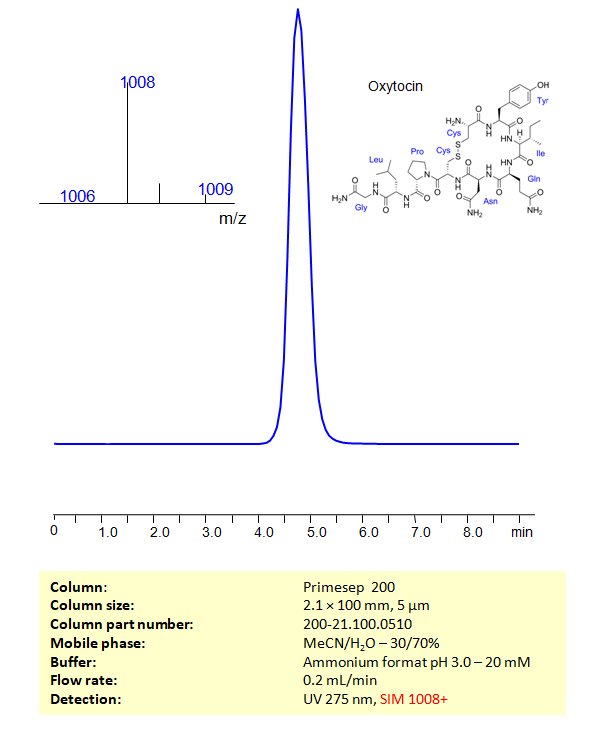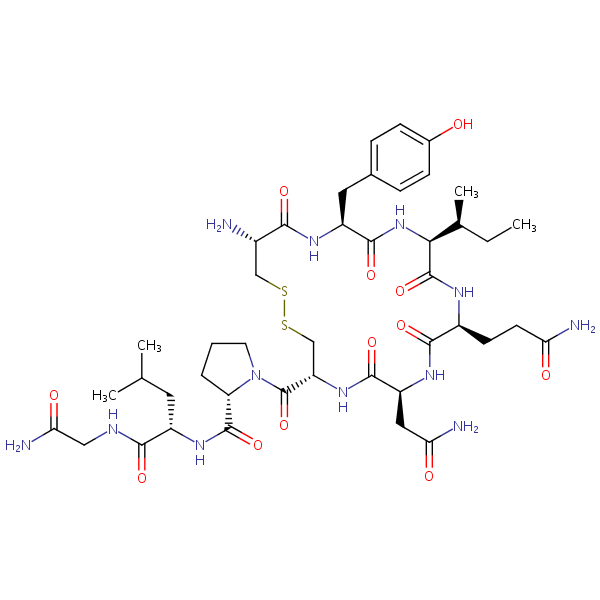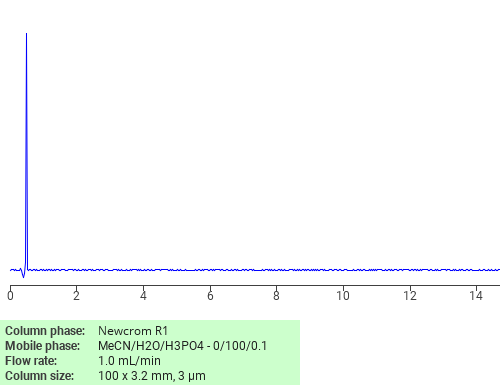| CAS Number | 50-56-6 |
|---|---|
| Molecular Formula | C43H66N12O12S2 |
| Molecular Weight | 1007.191 |
| InChI Key | XNOPRXBHLZRZKH-DSZYJQQASA-N |
| LogP | -2.48 |
| Synonyms |
|
Applications:
HPLC-UV Method for Analysis of Oxytocin on Primesep 200 Column
September 6, 2023
High Performance Liquid Chromatography (HPLC) Method for Analysis of Oxytocin on Primesep 200 by SIELC Technologies
Separation type: Liquid Chromatography Mixed-mode

Oxytocin is a neuropeptide and a hormone that plays a significant role in social bonding, sexual reproduction, childbirth, and the period after childbirth.
Oxytocin is a peptide hormone and neuropeptide that plays a crucial role in social bonding, reproduction, and childbirth. It is often called the “love hormone” or “bonding hormone” because of its association with social interactions, including maternal behaviors, bonding between couples, and even the bond between humans and their pets.
Oxytocin is a neuropeptide and a hormone that plays a significant role in social bonding, sexual reproduction, childbirth, and the period after childbirth. Here’s a breakdown of its classification and functions:
1. Chemical Classification:
- Oxytocin is a peptide hormone, meaning it’s made up of a short chain of amino acids. Specifically, oxytocin is a nonapeptide (consists of nine amino acids).
- Its chemical structure is Cys-Tyr-Ile-Gln-Asn-Cys-Pro-Leu-Gly, and it has a disulfide bond between the two cysteine residues.
2. Production and Release:
- Oxytocin is produced in the hypothalamus and stored in and secreted by the posterior pituitary gland.
- It’s released into the bloodstream in response to various stimuli, such as stretching of the cervix and uterus during labor, nipple stimulation from breastfeeding, and more.
3. Functions:
- Reproductive System: Oxytocin facilitates uterine contractions during childbirth and helps the milk ejection reflex during breastfeeding.
- Social Behavior: There’s evidence suggesting that oxytocin plays a role in social bonding, attachment, and even trust between individuals. It’s sometimes referred to as the “love hormone” or “bonding hormone” because of these effects.
- Stress and Anxiety: Oxytocin may have a protective role in stress situations, potentially reducing anxiety and encouraging social interaction.
Oxytocin can be retained, and analyzed on a Primesep 200 mixed-mode stationary phase column using an isocratic analytical method with a simple mobile phase of water, Acetonitrile (MeCN), and a Sulfuric acid as a buffer. This analysis method can be detected in the UV 200 nm.
High Performance Liquid Chromatography (HPLC) Method for Analyses of Oxytocin
Condition
| Column | Primesep 200, 2.1 x 100 mm, 5 µm, 100 A, dual ended |
| Mobile Phase | Gradient MeCN – 10-70%, 10 min |
| Buffer | H2SO4 – 0.2% |
| Flow Rate | 0.2 ml/min |
| Detection | UV 200 nm |
| Peak Retention Time | 7.77 min |
Description
| Class of Compounds | Neuropeptide, Hormone |
| Analyzing Compounds | Oxytocin |
Application Column
Primesep 200
Column Diameter: 2.1 mm
Column Length: 100 mm
Particle Size: 5 µm
Pore Size: 100 A
Column options: dual ended

HPLC-MS Method for Analysis of Oxytocin on Primesep 200 Column
September 1, 2023
High Performance Liquid Chromatography (HPLC) Method for Analysis of Oxytocin on Primesep 200 by SIELC Technologies.
Separation type: Liquid Chromatography Mixed-mode

Oxytocin is a neuropeptide and a hormone that plays a significant role in social bonding, sexual reproduction, childbirth, and the period after childbirth.
Oxytocin is a peptide hormone and neuropeptide that plays a crucial role in social bonding, reproduction, and childbirth. It is often called the “love hormone” or “bonding hormone” because of its association with social interactions, including maternal behaviors, bonding between couples, and even the bond between humans and their pets.
Oxytocin is a neuropeptide and a hormone that plays a significant role in social bonding, sexual reproduction, childbirth, and the period after childbirth. Here’s a breakdown of its classification and functions:
1. Chemical Classification:
- Oxytocin is a peptide hormone, meaning it’s made up of a short chain of amino acids. Specifically, oxytocin is a nonapeptide (consists of nine amino acids).
- Its chemical structure is Cys-Tyr-Ile-Gln-Asn-Cys-Pro-Leu-Gly, and it has a disulfide bond between the two cysteine residues.
2. Production and Release:
- Oxytocin is produced in the hypothalamus and stored in and secreted by the posterior pituitary gland.
- It’s released into the bloodstream in response to various stimuli, such as stretching of the cervix and uterus during labor, nipple stimulation from breastfeeding, and more.
3. Functions:
- Reproductive System: Oxytocin facilitates uterine contractions during childbirth and helps the milk ejection reflex during breastfeeding.
- Social Behavior: There’s evidence suggesting that oxytocin plays a role in social bonding, attachment, and even trust between individuals. It’s sometimes referred to as the “love hormone” or “bonding hormone” because of these effects.
- Stress and Anxiety: Oxytocin may have a protective role in stress situations, potentially reducing anxiety and encouraging social interaction.
Oxytocin can be retained, and analyzed on a Primesep 200 mixed-mode stationary phase column using an isocratic analytical method with a simple mobile phase of water, Acetonitrile (MeCN), and a Ammonium format as a buffer. This analysis method can be detected in the UV 275 nm.
High Performance Liquid Chromatography (HPLC) Method for Analyses of Oxytocin
Condition
| Column | Primesep 200, 2.1 x 100 mm, 5 µm, 100 A, dual ended |
| Mobile Phase | MeCN/H2O – 30/70% |
| Buffer | Ammonium Format pH 3.0- 20 mM |
| Flow Rate | 0.2 ml/min |
| Detection | UV 275 nm, LCMS SIM 1008+ |
| Peak Retention Time | 4.77 min |
Description
| Class of Compounds | Neuropeptide, Hormone |
| Analyzing Compounds | Oxytocin |
Application Column
Primesep 200
Column Diameter: 2.1 mm
Column Length: 100 mm
Particle Size: 5 µm
Pore Size: 100 A
Column options: dual ended

Separation of Oxytocin on Newcrom R1 HPLC column
May 16, 2018
Oxytocin can be analyzed by this reverse phase (RP) HPLC method with simple conditions. The mobile phase contains an acetonitrile (MeCN), water, and phosphoric acid. For Mass-Spec (MS) compatible applications the phosphoric acid needs to be replaced with formic acid. Smaller 3 µm particles columns available for fast UPLC applications. This liquid chromatography method is scalable and can be used for isolation impurities in preparative separation. It also suitable for pharmacokinetics.
Application Column
Newcrom R1
The Newcrom columns are a family of reverse-phase-based columns. Newcrom A, AH, B, and BH are all mixed-mode columns with either positive or negative ion-pairing groups attached to either short (25 Å) or long (100 Å) ligand chains. Newcrom R1 is a special reverse-phase column with low silanol activity.
Select options



